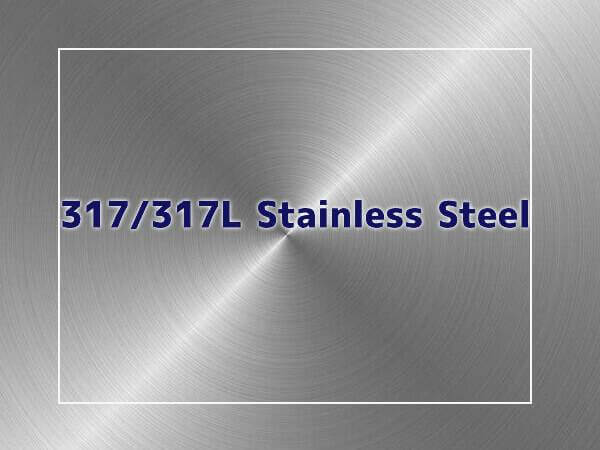
317L stainless steel is a molybdenum-bearing Austenitic chromium-nickel steel, compared to 304L and 316L, low carbon 317L possesses more molybdenum, chromium, and nickel element, which helps 317L provide better corrosion resistance characteristics, The low carbon content makes it suitable for welding without sensitization to intergranular corrosion caused by chromium carbide precipitation in the grain boundaries.
Stainless Steel 317L offers higher creep, stress-to-rupture, and tensile strength at elevated temperatures than conventional stainless steels. It is a low carbon or “L” grade which provides resistance to sensitization during welding and other thermal processes.
317L can be used for many applications, especially in sulfurous acid compounds environment, alloy 317L is non-magnetic in the annealed condition, but it may exhibit a little magnetism during welding or after welding.
317, 317L Stainless Steel Chemical Composition
| C | Mn | P | S | Si | Ni | Cr | Mo | Fe | |
|---|---|---|---|---|---|---|---|---|---|
| 317 | 0.08 | 2.00 | 0.040 | 0.030 | 1.0 | 11-14 | 18-20 | 3.0-4.0 | Balance |
| 317L | 0.03 | 2.00 | 0.040 | 0.030 | 1.0 | 11-15 | 18-20 | 3.0-4.0 | Balance |
317, 317L Stainless Steel Mechanical Properties
| Tensile Strength(Mpa) | Yield Point(Mpa) | Elongation(%) | HARDNESS | |
|---|---|---|---|---|
| 317 | 515 | 205 | 35 | 95 |
| 317L | 515 | 205 | 35 | 95 |
Through the controlled addition of nitrogen (0.1 max), it is common for 317L to meet the mechanical properties of 317.
317, 317L Stainless Steel Equivalent Grades
| AISI | UNS | DIN | EN | JIS | GB |
|---|---|---|---|---|---|
| 317 | S31700 | SUS317 | 06Cr19Ni13Mo3 | ||
| 317L | S31703 | 1.4438 | X2CrNiMo18-15-4 | SUS317L | 022Cr19Ni13Mo3 |
317L And 1.4438 Comparison
| Standard | Grade | C | Mn | Cr | Ni | Mo | N |
|---|---|---|---|---|---|---|---|
| ASTM A240 | 317L | ≤0.030 | ≤2.00 | 18.0-20.0 | 11.0-15.0 | 3.0-4.0 | ≤0.10 |
| EN 10028-7 | 1.4438 | ≤0.030 | ≤2.00 | 17.5-19.5 | 13.0-16.0 | 3.0-4.0 | ≤0.10 |
| EN 10088-2 | 1.4438 | ≤0.030 | ≤2.0 | 17.5-19.5 | 13.0-16.0 | 3.0-4.0 | ≤0.10 |
| EN 10088-3 | 1.4438 | ≤0.030 | ≤2.00 | 17.5-19.5 | 13.0-16.0 | 3.0-4.0 | ≤0.10 |
| EN 10088-4 | 1.4438 | ≤0.030 | ≤2.0 | 17.5-19.5 | 13.0-16.0 | 3.0-4.0 | ≤0.10 |
317L Stainless Steel Physical Properties
| Density | Melting Point | Specific Heat | Thermal Conductivity | Coefficient Of Expansion | Electrical Resistivity | Elastic Modulus |
|---|---|---|---|---|---|---|
| G/Cm3 | (℃) | [J/(Kg·K)] 0~100 ℃ | [W/(M·K)] 100 ℃ | ( 10-6/K )0~100 ℃ | ( NΩ.M | KN/Mm2 |
| 7.99 | 1371 – 1421 | 500 | 16.3 | 16.6 | 790 | 193 |
Corrosion Resistance
Alloy 317L has excellent corrosion resistance in a wide range of chemicals. It resists attacks in sulfuric acid, acidic chlorine and phosphoric acid. The corrosion resistance of 317 and 317L should be the same in any given environment. The one exception is where the alloy will be exposed to temperatures in the chromium carbide precipitation range of 800 – 1500°F (427 – 816°C). Because of its low carbon content, 317L is the preferred material in this service to guard against intergranular corrosion. In general, austenitic stainless steels are subject to chloride stress corrosion cracking in halide service. Although 317L is somewhat more resistant to stress corrosion cracking than 304/304L stainless steels, because of its higher molybdenum content, it is still susceptible. The higher chromium, molybdenum and nitrogen content of 317L enhance its ability to resist pitting and crevice corrosion in the presence of chlorides and other halides. The Pitting Resistance Equivalent including Nitrogen number (PREN) is a relative measure of pitting resistance. The following chart offers a comparison of Alloy 317L and other austenitic stain
Heat Treatment
Working temperatures of 1652 – 2102°F (900 – 1150°C) are recommended for hot working processes. Do not work this alloy below 1742°F (950°C). If the final forming temperature falls below this threshold, a solution anneal of 1976 – 2156°F (1080 – 1180°C) is necessary. Rapid quenching is required
Welding
317L stainless steel is suitable for all common fusion and resistance methods, with the exception of oxyacetylene welding, low carbon filler metals with molybdenum content higher than that of 317L, or a nickel-base filler metal with sufficient chromium and molybdenum content to exceed the corrosion resistance of 317L should be used to weld 317L steel, post weld heat treatment is not necessary.
Typical Applications
- Absorber towers
- Boilers
- Condenser tubes
- Fittings
- Heat exchangers
- Outlet and inlet ductwork
- Pipes
- Piping systems
- Pressure vessels
- Slurry tanks
- Stack liners
- Tanks
- Valves
Related References
- ASTM A240/ASME SB240, Standard Specification for Chromium and Chromium-Nickel Stainless Steel Plate, Sheet, and Strip for Pressure Vessels and for General Applications
- ASTM A480, Standard Specification for General Requirements for Flat-Rolled Stainless and Heat-Resisting Steel Plate, Sheet, and Strip
- EN 10088-2, Stainless steels. Technical delivery conditions for sheet/plate and strip of corrosion-resisting steels for general purposes
- EN 10088-3, Stainless steels. Technical delivery conditions for semi-finished products, bars, rods, wire, sections and bright products of corrosion-resisting steels for general purposes
- EN 10088-4, Stainless steels. Technical delivery conditions for sheet/plate and strip of corrosion-resisting steels for construction purposes
- EN 10088-5, Stainless steels. Technical delivery conditions for bars, rods, wire, sections and bright products of corrosion-resisting steels for construction purposes
- ASTM A249, Standard Specification for Welded Austenitic Steel Boiler, Superheater, Heat-Exchanger, and Condenser Tubes
- ASTM A213, Standard Specification for Seamless Ferritic and Austenitic Alloy-Steel Boiler, Superheater, and Heat-Exchanger Tubes
- ASTM A312, Standard Specification for Seamless, Welded, and Heavily Cold Worked Austenitic Stainless Steel Pipes
- ASTM A276, Standard Specification for Stainless Steel Bars and Shape
